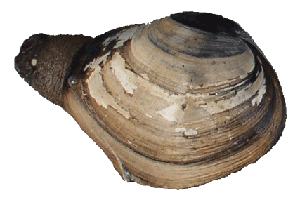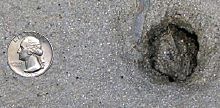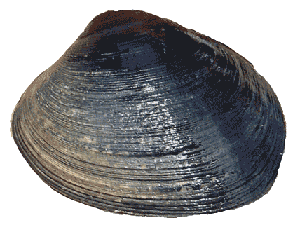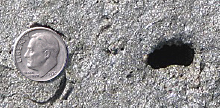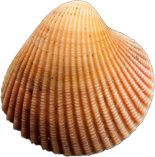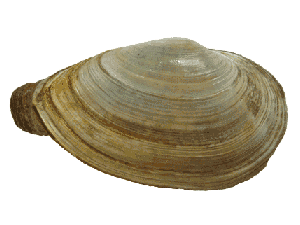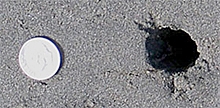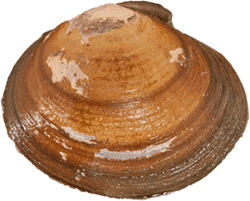
How to bay clam
Oregon estuaries are rich with many species of clams, although only a few of these species are commonly harvested. Gaper, butter, cockle, littleneck, softshell and purple varnish clams are popularly harvested due to their abundance, size and taste. A wide variety of other bivalve species are found in Oregon estuaries, but not commonly harvested due either to their scarcity or poor taste.

Harvesting bay clams can be fun and relaxing. However, your clamming adventure will be more successful and enjoyable if you know a little about the clams you'll be digging for, digging techniques and what the weather's going to be like at the beach.
Before you go
- Be sure to check biotoxin safety closures before harvesting these clams by going to ODA's website or by calling the shellfish harvest hotline 1-800-448-2474.
- See Oregon Sport Fishing Regulations for information on the daily catch limits for clams.
- Decide what to dig for.
- Gather your gear – rakes or shovel, boots or waders, container for clams such as a bucket or mesh bag.
- Check the tide, the best clamming will be during the lowest tides.
Gaper clam
About: Gaper clams are found in several Oregon estuaries. They are known by a variety of names including blue, empire, horse and horseneck clams. They are Oregon's largest common clam. Geoducks can grow much larger (as much as 10 pounds!) but are rarely found south of Puget Sound in Washington.
Daily limit: 12, out of a total of 20 bay clams (regulations)
Use: Clam steaks, chowder
Digging method: Shovel
Habitat: High salinity sandy and/or muddy areas
Digging tips: Dig around the show, coming in from the side, and not straight down on it to avoid slicing off the neck or breaking the shell. When you've dug almost to the depth of the clam, feel around gently with the shovel or your hand so you don't break the shell. Although a clam with a broken shell is still good, sharp edges of a broken shell can be dangerous. After you've removed the clam refill the hole. To avoid cave ins while digging, bring a five gallon bucket with the bottom cut out. Place the bucket in the substrate once there's enough room. This will prevent the hole from caving in and will allow you to dig easier and not break clams as often.
Show: Circular hole up to 1 ¾ inches in diameter. Lagest clam show in Oregon. Their necks are often visible within the show.
Butter clam
Learn to dig butter clams (video)
About: Butter clams are found throughout Oregon's nearshore areas and larger estuaries. Butter clams are excellent burrowers and abundant in shell, sandstone and even rocky areas. Diggers harvest most butter clams from sandy and muddy substrates where it's easier to dig. Butter clams are most often found in large estuarine systems, such as Tillamook, Yaquina, and Coos, because of their higher salinity preference. They are known by a variety of names including Washingtons, Martha Washingtons, beefsteak, quahog.
Daily limit: 20, in aggregate with other bay clams (regulations)
Use: Chowder, steamed, steaks
Digging method: Shovel, potato fork
Habitat: High salinity gravel, mud, or sandy areas
Digging tips: Dig around the show, coming in from the side, and not straight down on it to avoid slicing off the neck or breaking the shell. When you've dug almost to the depth of the clam, feel around gently with the shovel or your hand so you don't break the shell. Although a clam with a broken shell is still good, sharp edges of a broken shell can be dangerous. After you've removed the clam refill the hole.
Show: Butter clams have a distinctive rectangular show. The shape is usually described as looking like a flathead screwdriver was stuck in the mud.
Cockle
About: Cockles are "hard shelled" clams and because of their stout shells, they do not have to bury as deeply as other common bay clams. Larger cockles can even be found feeding on the sand's surface. Cockles are one of few bay clams that are known to move horizontally through the estuary.
Daily limit: 20, in aggregate with other bay clams (regulations)
Use: Chowder, steamed
Digging method: Rake, hand
Habitat: High salinity sandy areas
Digging tips: Rake through the sand until you feel the clunk of the hard shell.
Show: Typically look like two pencil holes next to each other.
Littleneck clam
Digging littleneck clams (video)
About: Littleneck clams are highly prized. These clams are often confused with Manila littleneck clams, a smaller related (but non-native) clam available on local markets. Only Tillamook, Yaquina and Coos bays have littleneck clams.
Daily Limit: 36, in aggregate with other clams (regulations)
Use: Steamed
Digging Method: Rake
Habitat: Sand, mud, gravel or rock in high salinity areas
Digging tips: Can be found in rocky nearshore areas within six inches of the surface.
Show: Deflated figure-8 shaped hole, ½ to ¾ inches long.
Softshell clam
How to dig softshell clams (video)
About: Softshell clams occur in almost all of Oregon’s estuaries and they can be found very high into the estuary. Softshell clams are native to the East Coast, and are believed to have been introduced to Oregon in the late 1800s, about the same time people tried to establish a fishery for the eastern oyster.
Daily limit: 36 (regulations)
Use: Chowder, steamed, steaks
Digging method: Shovel, clam gun
Habitat: Brackish , muddy areas
Digging tips: Unlike the other four common species of bay clams, softshell clams are found not only in the lower estuary, but fairly high up as well.
Show: Softshell clams have variable shows. They are generally round, but can also be oblong or rectangular.
Purple varnish clam
Digging purple varnish clams (video)
About: Purple varnish clams were introduced to Oregon, most likely from ballast waters from Asia.
Daily limit: 72 (regulations)
Use: Steamed
Digging method: Shovel
Habitat: Cobble to muddy substrate
Digging tips: Purple varnish clams are found in very high densities.
Show: Small keyhole shaped hole, 1/8 inch long.
Clamming ethics
Make a plan
Harvest only what you need and know how to prepare the clam once you harvest it.
Learn what to look for
Knowing your clam shows will help assure you're digging the species of clam you are targeting.
Know how to properly harvest your target clam
Think about your technique for digging clams. Many species are easily broken, causing a dangerous situation for your fingers and additional cleaning work. Many diggers prefer to dig close to the depth of the clam and then do the remaining work carefully with their hands.
Unbroken butter, cockle, and littleneck clams can be returned as these species have the ability to dig themselves back in. Gaper and softshell clams are incapable of adequately digging back to their needed depth once removed and therefore are illegal to return.
Avoid eelgrass
Eelgrass provides essential habitat for a number of fish and invertebrates. Avoiding areas of eelgrass is fairly easy as it tends to be patchy within clam beds. Once dug up or trampled, the eelgrass can no longer provide the habitat sought by fish and invertebrates.
Refill your holes
Digging clams can often require the movement of a significant amount of substrate. When piled up, mud and sand can hinder the access to the surface of other clams below. Simply pushing the material back in the hole eases the impact on the clam bed for your next trip.
FAQ
What's that long clear stick looking thing in a clam?
It is called a crystalline style which is an element of the digestive tract. The style is secreted by the style sac which is an expansion of the stomach. It contains only digestive enzymes which are progressively dissolved in the stomach and takes part in the digestive process.
How long do bay clams live?
Many common bay clams found in Oregon have a maximum life expectancy of between 5 and 20 years. Geoducks, a rare find in Oregon, are a notable exception to these shorter lived species; they have been aged at beyond 140 years and are one of the longest lived animals in the world.
I have a hard time digging clams or cannot dig them at all due to a disability. Is there a permit that allows for someone else to assist me in digging clams?
Yes. ODFW offers an Oregon Disabilities Hunting and Fishing Permit (includes shellfish harvest) for people who have written certification from their physician that they meet certain criteria. Here is the application (pdf). A recreational shellfish license is still required.
Other resources
Printable quick reference for bay clams of Oregon (pdf)
Header photo by Meow Cat, Flickr

